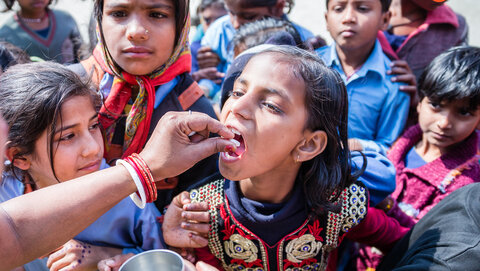LF and children

LF and children?
In children, the infection from LF is usually symptomless and not clinically detectable. The damage caused by adult worms in the lymphatic system develops slowly, and it is generally not apparent until children are four or five years of age. However, swollen lymph glands may be observed as early as two years of age. At about seven years, about 30% of infected children will start to show ultrasound-detectable, irregular ballooning of the tiny walled lymphatic ducts and some will have noticeably swollen lymph glands.
Disease progression in girls
By about 13 years, girls may start to show clinically visible signs of infection of the lymph vessels in the leg. Further cumulative damage to the lymphatic drainage system predisposes them to lymphoedema (an abnormal accumulation of lymph fluid in the tissues causing swelling of a limb). This may progress to elephantiasis (painful and disfiguring swelling of the leg, arm, breast or genitals, up to several times their normal size, with thickening of the skin) in adulthood.
Disease progression in boys
By about 11 years, boys may start to show detectable ballooning of the lymphatic vessels in their scrotum. By about 13 years, they may start to develop hydrocele - a fluid-filled, balloon-like enlargement of the sacs around the testes. Scrotal nodules often develop in adulthood and further bacterial infection can lead to massive enlargement of the scrotum and gross deformation of the penis.
Immunological responses
Histologically, dilatation and proliferation of the lymphatic endothelium can be identified, and the abnormal lymphatic function associated with these changes can be readily documented by lympho-scintigraphy. Interestingly, despite the earlier paradigm that pathology associated with lymphatic filarial diseases was primarily the result of immune-mediated inflammatory responses, all of these changes can occur in the absence of such overt inflammatory responses and, even by themselves, and can lead to both lymphoedema and hydrocele formation. The immune system during the development of this 'non-inflammatory pathology' keeps itself 'down-regulated' through the production of contra-inflammatory immune molecules; specifically, the characteristic mediators of Th2-type T-cell responses (IL-4, IL-5, IL-10) and antibodies of the IgG4 (non-complement-fixing) subclass that serve as "blocking antibodies". Such adaptations do, of course, serve to promote the biological principle of parasitism in which a satisfactory balance between parasite 'aggressiveness' and host responsiveness must evolve to maintain this special relationship.
Less commonly, boys may also develop lymphoedema and elephantiasis of the extremities, similar to girls. However, the parasites in males seem to prefer the lymphatics of the scrotum over those of the extremities. Thus, genital disease is more common in males, and is the most common of all clinical manifestations of LF.